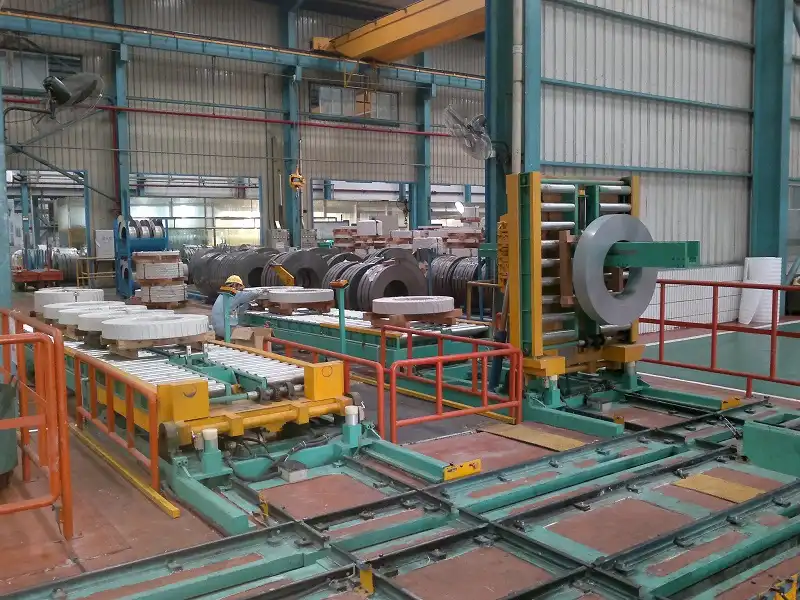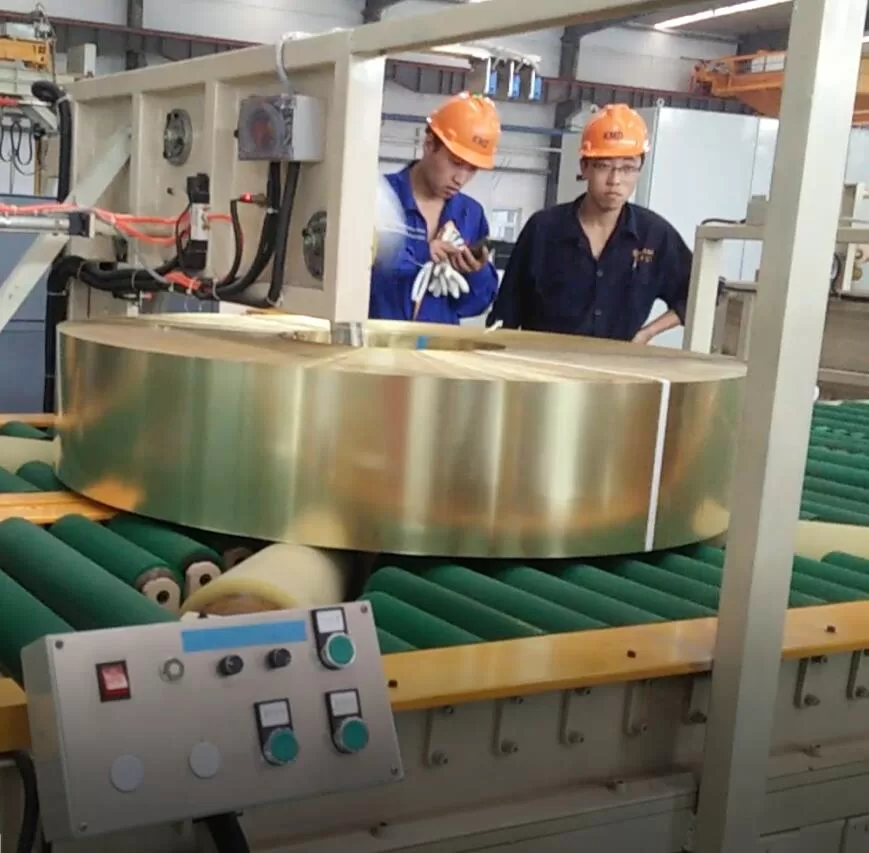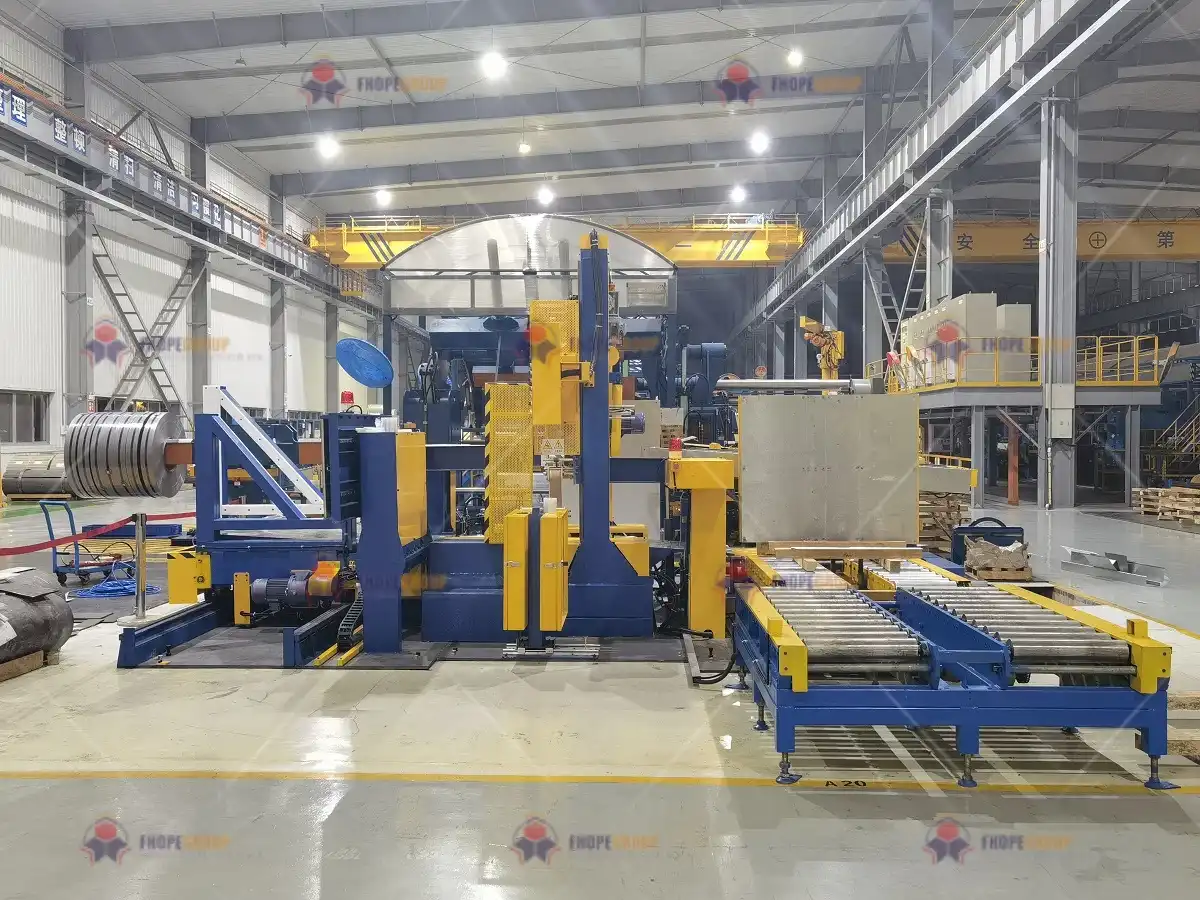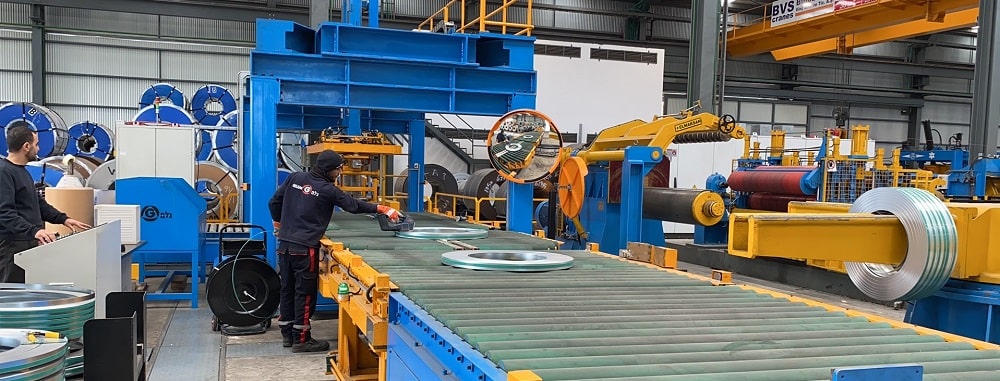Are you running a steel mill, constantly fighting to keep costs down and efficiency up? You know the daily pressures. Aging equipment can be a source of unexpected downtime. Finding reliable workers for tough, physical jobs is a constant challenge. And every coil that leaves your plant needs to be perfectly packed to avoid costly damage during shipping. These small issues can add up, creating a major bottleneck that holds your entire operation back from its true potential.
I've seen it happen many times. A simple delay in the packing station can cause a backlog on the production line. A single workplace injury from manual handling can lead to lost time and insurance headaches. An improperly wrapped coil arrives at a customer's site damaged, hurting your reputation and your bottom line. These aren't just minor annoyances; they are real threats to your profitability and growth. What if you could turn your packing area from a source of problems into a strategic advantage? This is exactly the transformation I'm seeing in steel plants across Malaysia, and the solution is the switch to fully automatic coil packing lines.
Steel plants in Malaysia are adopting automatic coil packing lines primarily to slash operational costs, significantly boost worker safety, and deliver consistently high-quality packaging required by competitive global markets. This move also allows them to integrate packing operations with their plant-wide management systems, unlocking powerful data for improving efficiency and traceability.

The reasons might seem obvious on the surface. Automation saves labor, and machines are faster. But as a fellow engineer and business owner, I know you need to look deeper than that. The real value isn't just in what you save, but in what you gain. It's about building a more resilient, predictable, and profitable operation. I started my career on the factory floor before building my own company, SHJLPACK. I’ve had my hands on these machines and helped clients solve these exact problems. Let’s break down the specific drivers behind this trend in Malaysia and explore how they can apply to your own strategic goals.
How Can Automation Address Rising Labor Costs and Skill Gaps?
Finding skilled and willing workers for the physically demanding job of coil packing is getting tougher every year. You invest time and money training new employees, only to see them leave for less strenuous work, forcing you to start the process all over again. What happens when your most experienced and reliable packing crew leader decides to retire? The knowledge and consistency they provided can walk right out the door with them, leaving a critical gap in your operations.
Automation directly solves these labor challenges by replacing repetitive, hazardous, and physically demanding manual tasks with a reliable, 24/7 automated system. This move dramatically reduces your dependence on a fluctuating labor market, cuts ongoing recruitment and training costs, and empowers you to reassign your valuable human workforce to safer, higher-skilled roles like quality control and system supervision.

The Hidden Costs of Manual Packing
When we analyze the cost of labor, we often stop at salary and benefits. But the true cost of manual packing runs much deeper. As a business owner, you have to consider the full picture. These are the costs that don't always show up on a simple P&L sheet but eat away at your profit margin every single day.
First, there's the cost of inconsistency and human error. A tired or distracted worker might use too much packing material on one coil and not enough on the next. Too much material is a direct waste of money. Too little can lead to product damage, customer claims, and costly returns. Then there's the risk of injury. Coil handling is heavy, dangerous work. A single serious accident can result in devastating consequences for the employee, along with high insurance premiums, legal fees, and lost production time for the company. These are liabilities that an automated system virtually eliminates.
| Cost Factor | Manual Packing | Automatic Packing Line |
|---|---|---|
| Labor | High & Volatile (Salaries, Overtime, Benefits) | Low & Predictable (Supervision, Maintenance) |
| Training | Continuous & Costly (High Turnover) | One-time & Minimal (System Operators) |
| Safety | High Risk (Lifting, Repetitive Strain) | Very Low Risk (Guarded, Automated) |
| Material Use | Inconsistent & Wasteful | Precise & Optimized |
| Error Rate | Prone to Human Error (Damage, Re-work) | Near-Zero Error Rate |
Bridging the Skills Gap
The challenge of an aging workforce is real. Across the manufacturing sector, experienced workers who have spent decades honing their craft are retiring. Younger generations are often less interested in taking on physically demanding industrial jobs. This creates a dangerous "skills gap." An automatic packing line acts as a permanent solution to this problem. It captures the "perfect" packing process in its software. Every coil is wrapped with the same precision, the same tension, and the same level of protection, every single time. It doesn't get tired, it doesn't get distracted, and its performance doesn't depend on who is operating it. This ensures that your packing quality remains consistently high, day in and day out, safeguarding your product and your reputation. It allows you to transform the job description from "manual laborer" to "system technician," a role that is more appealing to a modern workforce and adds more value to your company.
What is the Real ROI of an Automatic Coil Packing Line Beyond Labor Savings?
When you consider a major equipment investment, the first calculation is almost always labor savings. It's the easiest number to quantify. But if your analysis stops there, you are missing out on the most significant financial benefits. This is a trap I've seen many factory managers fall into. They underestimate the true value because they aren't measuring all the ways a new system impacts the business. What if the real return on investment (ROI) is hidden in material savings, increased production capacity, and enhanced product protection?
The true ROI of an automatic coil packing line comes from a combination of factors that go far beyond labor reduction. It includes major savings from optimized packing material usage, lower energy consumption per coil, the near-elimination of product damage during handling and shipping, and a significant increase in throughput that allows you to process and ship more products without changing your production lines.

Precision in Material and Energy Use
In a manual operation, material consumption is highly variable. One worker might apply three layers of stretch film, while another applies five. This inconsistency adds up to a significant amount of wasted material over the course of a year. An automatic wrapper is programmed to use the exact amount of material needed for optimal protection—no more, no less. It applies the film with consistent tension and overlap, creating a more secure and professional-looking package while using significantly less material.
Let’s look at a simple example:
| Metric | Manual Wrapping | Automatic Wrapping | Annual Savings (Example) |
|---|---|---|---|
| Film per Coil | 1.2 kg (Average) | 0.8 kg (Precise) | 200,000 kg/year |
| Energy | Ancillary equipment runs constantly | Motors run only when needed (VFDs) | 10-15% reduction in packing energy |
This precision directly impacts your bottom line and contributes to sustainability goals by reducing plastic waste. Similarly, modern automated lines are designed for energy efficiency. They use variable frequency drives (VFDs) and smart power management systems, so motors and hydraulic pumps only consume significant power when they are actively working. This is a stark contrast to older or manual systems where equipment might run continuously, wasting electricity. This aligns perfectly with a goal of reducing unit energy consumption.
Unlocking Your True Production Capacity
In many steel mills, the packing station is the final bottleneck. Your melt shop and rolling mills might be capable of producing coils at a high rate, but if your packing area can't keep up, the entire operation slows down. Coils pile up, waiting to be wrapped and shipped. This is a hidden capacity killer. An automatic packing line is designed for high throughput. It can match the speed of your production lines, eliminating that bottleneck. This means you can increase your total output and sales revenue without having to invest in more expensive upstream production equipment. By synchronizing your packing speed with your production speed, you increase your overall capacity utilization, a key goal for any forward-thinking plant manager. You're not just buying a wrapping machine; you're unlocking the full potential of your entire plant.
How Does an Integrated Packing Line Enhance Production Stability and Data Visibility?
In your plant, you probably have sophisticated systems monitoring your furnace and rolling mills. You have real-time data on temperature, speed, and thickness. But what happens when the coil reaches the end of the line? For many, the packing and shipping area is a "data black hole." Information is recorded manually on paper or entered into a separate system, if at all. This lack of real-time visibility makes it impossible to have a truly connected, smart factory. You can't optimize what you can't measure.
An integrated automatic packing line serves as the final, critical link in your data chain, connecting directly to your plant’s Manufacturing Execution System (MES) or ERP. It provides a constant stream of real-time data on every coil packed, including cycle times, material consumption, and weight. This transforms your packing station from a disconnected black box into a transparent, data-rich hub that enhances production stability and enables data-driven decision-making.

From a Black Box to a Data Hub
Imagine this: a coil arrives at the packing station. An automated scanner reads its unique ID. Instantly, the packing line communicates with your MES to retrieve the specific packing requirements for that customer's order. The line then automatically applies the correct wrapping paper, stretch film, and labels. Throughout this process, sensors are collecting data: the coil's exact weight, the amount of packing material used, and the total time taken for the cycle. Once complete, all this information is automatically sent back to your ERP system, updating the inventory status to "packed and ready for shipment." This eliminates manual data entry, prevents errors, and gives your sales and logistics teams a real-time view of finished goods.
The Power of Predictive Maintenance
Aging equipment is a major challenge because it leads to unpredictable failures and costly downtime. A modern, integrated packing line is different. It's built with smart sensors that monitor the health of its own components. This is the foundation of predictive maintenance, a key goal for any efficient operation.
| Maintenance Type | Description | Impact on Production |
|---|---|---|
| Reactive | Fix it after it breaks. | High. Unplanned downtime, production halts. |
| Preventive | Maintenance on a fixed schedule. | Medium. Can involve unnecessary work and downtime. |
| Predictive | Maintenance based on real-time data. | Low. Alerts are sent before failure, allowing for scheduled maintenance during planned downtime. |
Instead of waiting for a motor to burn out or a bearing to seize, the system can alert your maintenance team that a component is showing signs of wear. For example, it might detect increased vibration or higher energy draw from a specific motor. This allows you to schedule repairs during planned downtime, rather than having the line fail in the middle of a critical production run. This shift from reactive to predictive maintenance is fundamental to achieving high levels of equipment uptime and production stability. It directly addresses the challenge of aging equipment by replacing it with a system that tells you when it needs attention.
My Perspective: A Custom Solution for a Strategic Leader
I've outlined the trends in Malaysia and the technical benefits of automation. But I know that for a leader like you, running a major steel operation in Mexico, this is about more than just technology. It's about strategy. Your challenges with energy costs, aging infrastructure, environmental regulations, and your ambitious goals for digital transformation require a solution that is tailored to your specific reality. They require a partner who understands your business, not just a supplier who sells machines.
A modern automatic packing solution is not simply a piece of equipment; it is a strategic asset. For a steel plant with your scale and goals, a packing line can be specifically engineered to minimize energy consumption, designed for a phased rollout to manage capital investment, and built with an open data architecture that integrates seamlessly with your MES and analytics platforms. This directly supports your primary goals of reducing operating costs and driving your digital transformation forward.

Directly Addressing Your Challenges
I started SHJLPACK after spending years on the factory floor and then building my own successful packing machine business. I understand the journey and the pressures. When I look at your specific challenges, I see clear opportunities where a true partnership can make a difference.
-
Energy Cost Volatility: Your concern about energy prices is valid. Our latest packing line designs focus heavily on energy efficiency. We use high-efficiency motors, intelligent VFDs that ramp power up and down as needed, and hydraulic power packs that enter a low-power state when idle. These features aren't just add-ons; they are core design principles that can directly contribute to your goal of a 10% reduction in unit energy consumption.
-
Phased Modernization for Aging Equipment: You have equipment that's over 15 years old. A complete, plant-wide overhaul is a massive capital expense and a huge operational disruption. A more strategic approach is a phased implementation. We can work with you to identify the biggest bottleneck in your current packing process and automate that single point first. This provides an immediate ROI. Later, as capital becomes available, we can add automated conveying, strapping, and data integration modules. This modular approach allows you to modernize at a pace that makes financial sense.
-
The Partnership You're Looking For: You need more than a supplier; you need a strategic partner. This is the core of my company's mission. When you work with SHJLPACK, you are not just buying a machine. You are gaining access to my personal experience and my team's deep expertise. We don't just ship a crate to your door. We start with a detailed consultation to understand your unique workflow. We help you design the optimal layout, we oversee installation and commissioning, and we train your team to operate and maintain the system effectively. We ensure the line can communicate with your MES and provide the data your analytics platforms need. We become an extension of your engineering team, fully invested in helping you achieve your goals, whether it’s hitting that 95% capacity utilization or reducing overall operating costs by 8%.
Conclusion
Switching to an automatic coil packing line is more than an upgrade. It is a strategic move towards a safer, more efficient, and data-driven future for your steel plant.





